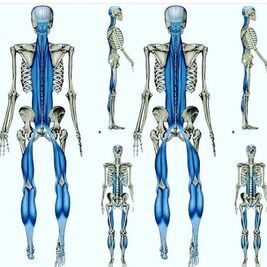|
Have you been hearing the word ‘fascia’ bandied about as you try and get your downdog on or swim into your updog and thought ‘wtf is this teacher talking about?’ Well my friends, today is your lucky day, time for an explanation of what fascia is and why we’re all getting excited about it. By Clare Shaw, Soul PHiiT & Soul Yoga Instructor Imagine that you’d been driving one car around for your entire life. You thought you knew exactly how it worked, you’d got it all figured out, and then suddenly discovered it had a whole other system of gears and special buttons. Not only that but this system had the potential to either make your life a whole lot easier or more difficult depending on what mode it was in. That’s kind of what its been like for people involved in movement industries. We were all totally cool with muscles, bones, tendons and ligaments, but then we realised the importance of fascia and it was a game changer.
We’ve actually known about fascia for a while but it was not considered of real significance until fairly recently. The reason being that fascia is something which exists in-between and around stuff, like a seam. I’m guessing we were all more concerned with looking at the obvious stuff, like gluteus maximus and the liver. Turns out, the stuff holding us together is pretty important. Imagine if one day, without warning, the seams went missing from your clothes. They’d fall apart and you’d be suddenly very naked. It could be an issue. Part of fascia’s role in the body is to hold us together and give us our form, almost like a morph suit. Without it we’d be a little bit… mushy and squishy (the technical description). Here is some stuff it does:
‘Fascia is the fibrous and gelatinous body wide web; it is a seam system that provides structure, protection, repair and body sense. It is the interconnected tissue, which gives your body form and shape. It links muscular proteins and other connective tissue structures, such as bones, ligaments and tendons.’ Jill Miller – The Roll ModelsGame Changer.Thanks to our new (ish) understanding of how the health of our fascia affects movement, we’ve been able to change how we approach injuries. We’ve realised that issues of balance, reduced range of motion and pain, are not just to do with individual muscle tightness or skeletal goings on. Often these issues are to do with compressed and hardened areas of fascia and through appropriate treatment we can restore health and wellness to areas of tightness and pain. Fascia has always been there but before it was a ‘silent’ player, or at least one we were blind and deaf to. Now however we’ve become attentive to the signals it’s sending. Previously the most common way of understanding body movement was through the lens of ‘isolated muscle theory’ – i.e. focusing only on the actions of individual muscles and what they’re directly adjacent to. Using this lens often means that if there is pain in the lower back we assume that the key to fixing the problem lies only in the adjacent muscles and tissues. In reality, often the pain is caused by a chain of events and is part of a systemic problem. If we widen our vision to look instead through a ‘fascia lens’ we see that each muscle is intertwined and indivisible from the entire chain of tissue and therefore a ‘pull’ anywhere in the body affects the entire chain, not just those muscles adjacent to it. This is micro vs macro thinking. Let’s consider the Earth as an example, and think in terms of a country (micro) and global (macro). I live in the UK and although I am in no way adjacent to the Amazon rainforest, the health of the rainforest affects life in the UK because we are part of the same system. Diminishing rainforest results in an overload of greenhouse gases, which in turn results in weather disruption i.e. droughts and flood and sea levels rising, until we’ve got a major disaster on our hands. Our bodies are a world in themselves; the systems and microcosms comparable to those of the earth. When one thing goes out of balance it has a knock on effect, even though it might not be obvious at first. To see (or feel) an example of this at work, we can look at a band of fascia that Thomas Myers (fascia geek extraordinaire) calls the superficial back line. This band of fascia runs from the heel up through the back of the legs, hips and back. Imagine a long strip of fabric and now imagine making a knot (or two) in that length of fabric. The strip of fabric is now effectively ‘knotted’ shorter. When we experience a reduced range of motion in a forward fold, often we blame the hamstrings, and yes maybe the hamstrings are tight but the hamstrings are connected and encased by fascia, which runs across the entire back body. It stands to reason then that if we unknot any part of that line, the entire line gains more range. The result of this is that if we release or un-knot the tissue along any of this strip we gain back some length.
0 Comments
Leave a Reply. |
Archives
October 2023
Categories
All
|
|
STAY UP TO DATE WITH THE LATEST NEWS & OFFERS:
about us: |
useful information:special offers & retreats:Welcome Offers
Book Pilates Weekend Retreats Workplace Pilates & Yoga Private Events Pilates Offers Hen Parties follow Soul Pilates: |
DOWNLOAD OUR APP:our classes:Beginner Pilates Classes
Advanced Pilates Classes Pilates Equipment Classes Pilates Reformer Classes Pilates Matwork Classes Pre & Post Natal Classes Class Timetable 1:1 Pilates Sessions Soul Pilates at Home |
© Soul Pilates Ltd 2023
City Centre Studio: 57 Queen Charlotte Street, Bristol BS1 4HQ
Bishopston Studio: Bristol North Baths, Gloucester Road, Bristol BS7 8BN
0117 214 1655 | [email protected]
Soul Pilates Limited is a company registered in England and Wales with company number 10525634
Registered Office: 57 Queen Charlotte Street, Bristol BS1 4HQ
City Centre Studio: 57 Queen Charlotte Street, Bristol BS1 4HQ
Bishopston Studio: Bristol North Baths, Gloucester Road, Bristol BS7 8BN
0117 214 1655 | [email protected]
Soul Pilates Limited is a company registered in England and Wales with company number 10525634
Registered Office: 57 Queen Charlotte Street, Bristol BS1 4HQ





